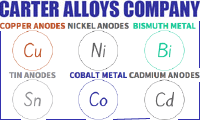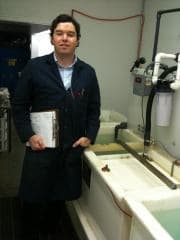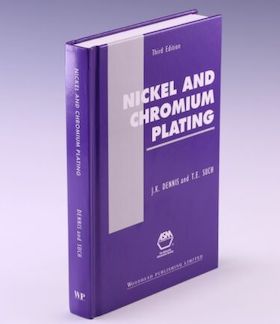
-----
Anodes for nickel plating: Difference between squares and S-rounds
adv.: Supplier of Copper Anodes, Nickel Anodes, Bismuth Metal, & Other Metal Products for Industry & The Arts

Q. Can Sulfur Free Nickel Crowns Replace S-nickel?
We have some sulfur free nickel crowns and was wondering if we can use that in place of the handy s nickel we are using in our plating baths
- Byron Illinois
May 29, 2024
A. Hi Sally. Unfortunately, I think nickel-free ⇩ ^ sulfur-free anodes will quickly cause you trouble. They will not properly dissolve and will cause anode polarization, reduction in nickel concentration, etc.
Luck & Regards,

Ted Mooney, P.E. RET
Striving to live Aloha
finishing.com - Pine Beach, New Jersey
Ted is available for instant help
or longer-term assistance.
A. Hi Ted,
How are you? I hope OK and enjoying life.
In your answer you probably mean sulfur-free anodes and shouldn't we also include that at higher chloride levels both can be used?
Take Care,

Harry van der Zanden
consultant - Tilburg, Netherlands
August 8, 2024
A. Hello Sally,
The sulfur content of your Ni anode material will depend on your bath chemistry. If you have a chemistry that was previously dependent upon the sulfur content to aid dissolution, then switching to a Low sulfur content anode will create problems and vice versa. Many high chloride bright Ni plating baths operate with an "R" styled crown or pellet with a low concentration of sulfur (.0002) %wt. However low or non chloride baths such as Forming solutions require (.025) %wt for adequate anode dissolution to occur. 0.025 is what is commonly referred to as an "S" round or crown.
The "S", "D", "R" and other names start to get a bit confusing once you start to dig into different brands, so check with your chemistry supplier or refer to your bath's data and make up guide for what type of anode material needs to be used with your solution. Hope this helps. Good luck.

Chance Dunstan
Electroplating/Forming/Coating Manager
Placerville, California USA
⇩ Related postings, oldest first ⇩
RFQ: I am looking for suppliers of sulfur-containing nickel sheets (as opposed to pellets or slugs) for use as anodes in nickel or nickel-alloy plating.
Emanuel Cooper- Yorktown Heights, New York
2001
Ed. note: This RFQ is outdated, but technical replies are welcome, and readers are encouraged to post their own RFQs. But no public commercial suggestions please ( huh? why?).
Q. WHAT IS THE METAL ANALYSIS DIFFERENCE BETWEEN 1" X 1" SQUARE NICKEL AND S-ROUND NICKEL BY METAL ANALYSIS?

Popatbhai B. Patel
electroplating consultant - Roseville, Michigan
2002
RFQ: Who has good prices on nickel s-rounds?
Lynn S [last name deleted for privacy by Editor]plating - Danville, Virginia
2003
Ed. note: This RFQ is outdated, but technical replies are welcome, and readers are encouraged to post their own RFQs. But no public commercial suggestions please ( huh? why?).
|
A. That will depend totally on the analysis that you get from the vendor. A word of caution, square is NORMALLY electrolytic nickel and S-rounds are sulfur depolarized nickel typically used in nickel sulfamate bath but should not be used in Woods Nickel Strike tanks. If they are both sulfur depolarized, then virtually the only difference is in the ease of handling and the way that they stack or nest in the anode baskets. You can get garbage from fly-by-night vendors. Quality of product from the main 2-3 manufacturers will be high and very consistent. James Watts- Navarre, Florida A. S-round nickel contains a small but essential amount of sulfur, whilst nickel squares are made from electroformed nickel and are of high purity. Offhand I cannot recall the amount of sulfur present in S nickel, but I think it is about 0.1% - no doubt someone else can give a more precise analysis. However, the presence of sulfur is very important as it allows S nickel to be used over a wide range of current densities and therefore the anode-cathode area relationship is not so important. It can also be used at a lower voltage compared to pure nickel, thereby saving energy. Furthermore, since it is more active than pure nickel, there is no need of the presence of chloride in the electrolyte to help dissolve the anodes. Chloride will induce stress in nickel, which can be disastrous in electroforming; saying that, many electroformers still use about 10 g/l chloride just to be on the safe side. S nickel will dissolve more uniformly than pure nickel, but it still should be used with anode bags, despite forming less sludge than pure nickel. Nickel squares are used primarily in titanium baskets, that MUST be bagged as pure nickel produces much more sludge. To promote nickel square dissolution, the electrolyte must contain a lot more chloride, which adds to the material and maintenance costs.  Trevor Crichton R&D practical scientist Chesham, Bucks, UK A. Rounds are usually "S-rounds", sulfur depolarized nickel. The squares are usually electrolytic nickel, with less or no sulfur. Anode suppliers distribute both and have the composition of both available for you.  Ted Mooney, P.E. Striving to live Aloha finishing.com - Pine Beach, New Jersey Ted is available for instant help or longer-term assistance. |
Q. Both nickel S round and nickel R round can be used in electroplating as anode.
I want to know the difference between these 2 materials in terms of composition and why 2 different materials exists and what is the advantage of using one material over the other?
What changes in the concentration can be expected when we switch from nickel S-round to nickel R-round?
Process Engineer - Singapore
September 25, 2008
A. Hi, Ranjith. The sulfur assists in anode corrosion, preventing the anodes from going passive. If you are doing conventional Watts' bright nickel plating, S rounds are the thing to use. If you are running a high chloride strike bath, the R Rounds may be more appropriate. If you are doing sulphamate electroforming, special techniques may be employed which use both types of anodes in separate compartments for the purpose of generating a controlled amount of "magic" stress reducer.
Please tell us about your nickel plating process. Thanks.
Regards,

Ted Mooney, P.E.
Striving to live Aloha
finishing.com - Pine Beach, New Jersey
Ted is available for instant help
or longer-term assistance.
Q. Sorry Mr. Ted Mooney,
I am bit late.
Actually we are doing plating nickel on copper paste and our solution contains nickel sulphate and nickel chloride.
Is this information is enough for you to explain more on my previous question.
Process Engineer - Singapore
October 7, 2008
A. Hi, Ranjith. For a conventional Watts' nickel bath (nickel sulphate / nickel chloride) the S-Rounds is usually used to promote anode dissolution / deter anode polarization.
Regards,

Ted Mooney, P.E.
Striving to live Aloha
finishing.com - Pine Beach, New Jersey
Ted is available for instant help
or longer-term assistance.
Q. If you switch from S rounds to R rounds what is the negative? The R rounds do not decompose as uniformly and the usage of R rounds would be more to make sure that uniformity of plating can be constant? The market is becoming increasingly tight on S rounds and the cost difference makes R rounds more beneficial.
J. Smith- Troy, Michigan
June 16, 2010
A. Hi, J. The theoretical problem is that the nickel will go passive and not dissolve into the plating solution. The result will be a rapid decline in nickel concentration, leading to plating inefficiency, rising pH, and a plating process out of control.
While it is possible to increase the chloride content to assist in anode dissolution, this raises other problems like excessive stress. It may be possible to run a Watts' nickel plating bath without sulfurized nickel anodes, but it is definitely the hard way :-)
Good luck.
Regards,

Ted Mooney, P.E.
Striving to live Aloha
finishing.com - Pine Beach, New Jersey
Ted is available for instant help
or longer-term assistance.
June 27, 2010
Q. We now using R-round nickel anode for Sulfamate batts nickel plating. Because of R-round distribution in Viet Nam we now consider to use R-square (1x1 inch) for substitute. Pls kindly let me know the difference between square & R-round nickel. What is the disadvantage of substitute and how to solve the problem that may appear. Thank you very much.
VU HONG QUAN- Viet Nam
August 18, 2011
A. Hi, cousin Vu.
Both anode materials are type R, so they should not cause significant problems. Many shops use R squares.
Regards,

Ted Mooney, P.E.
Striving to live Aloha
finishing.com - Pine Beach, New Jersey
Ted is available for instant help
or longer-term assistance.
Q. WHICH SIZE OF NICKEL metal (25 mm x 25 mm or 100 mm X 100 mm) IS THE BEST FOR USE IN NICKEL BASKETS?
RAJESH BASSI- LUDHIANA, Punjab, India
June 5, 2013
A. Hi Rajesh. I can't recall ever having seen the 100 mm x 100 mm (4" x 4") nickel squares. I would conjecture that they would cause bridging problems unless you are using very large anode baskets (wider than 4") -- but this is obviously supposition rather than experience.
Regards,

Ted Mooney, P.E.
Striving to live Aloha
finishing.com - Pine Beach, New Jersey
Ted is available for instant help
or longer-term assistance.
June 5, 2013
A. 10 by 10 are the same as 2.5 by 2.5 nickel; the only thing you will notice is that with 10 by 10 your baskets will be full with less material because they have big spaces between them, I like to use round pellets or nickel carbonyl method obtained nickel, they are more dense inside the baskets, and also is better to use type "s"; for me it gives better results because it has less tendency to passivate in the baskets. The other issue is that you have to compare the purity of the material.
They are produced the same way, the size of the cut is the only difference.
There is somebody that produces that nickel (pellets) in this page I saw his post one day offering this product.
- Bucaramanga Colombia
June 15, 2013
Q. Hi,
as per my last question,we are using the baskets of size 30"x6"x2" in our Nickel plating process and using the Ni-metal size of 4"x4". Is there any other difference using Ni-metal of 4"x4" or 1"x1" other than bridging.We measured the same current in both cases in the baskets.
Regards
Electroplating - Ludhiana, Punjab, India
June 20, 2013
A. Hi cousin Rajesh. If the vendor insists they are identical in composition and they're only cut to a different size, and you've received two responses here regarding the size, I don't think there is anything more to say. However, if they are from two different unknown vendors, then nobody can even hazard a guess. Good luck.
Regards,

Ted Mooney, P.E.
Striving to live Aloha
finishing.com - Pine Beach, New Jersey
Ted is available for instant help
or longer-term assistance.
June 2013
Recommended Nickel Anodes for Electroforming
Q. I have used Nickel "S" rounds since the 1980's for our nickel electroforming operation. The company may go to a different product. Can anyone give some feedback on nickel products that they use. Pros and Cons?
David KiminkiPlating Shop Employee - Dallas, Texas
February 18, 2016
A. Hi David. The "S" stands for sulfurized, and if you are able to continue obtaining sulfurized nickel, your life will be easier because regular nickel will go passive unless you add substantial chloride (and the problems it brings) to your electroforming bath.
Regards,

Ted Mooney, P.E.
Striving to live Aloha
finishing.com - Pine Beach, New Jersey
Ted is available for instant help
or longer-term assistance.
February 2016
Q. Is a nickel D crown anode the same thing as a nickel S round anode? The pictures look the same?
Pat Koerber- Milwaukee, Wisconsin, U.S.A.
March 28, 2019
A. Hi Pat. The "S" and the "D" both refer to "sulfur depolarized" ... so they are intended for the same purpose and are essentially the same thing.
Regards,

Ted Mooney, P.E. RET
Striving to live Aloha
finishing.com - Pine Beach, New Jersey
Ted is available for instant help
or longer-term assistance.
March 2019
Q. Thank you! One more question. Any disadvantage using the S-Pellets versus the D-Crown? The S-Pellet pricing is much better than the D-Crown.
Pat Koerber- Milwaukee, Wisconsin, U.S.A.
April 2, 2019
A. Hi again Pat. I'm not a nickel plater and don't stay in contact with the suppliers of nickel anode material, so I'm no expert on this. Further, we can't suggest superiority of one proprietary over another (why?), but my understanding is that they are equivalent. You can google them both for the about their advantages and try to judge what is significant versus what is just sales pap. Good luck.
Regards,

Ted Mooney, P.E. RET
Striving to live Aloha
finishing.com - Pine Beach, New Jersey
Ted is available for instant help
or longer-term assistance.
April 2019
Hi Pat,
One difference is D Crowns in button shape while S Pellets in ball shape. Last time S Pellets vendor also supply button shape S Rounds but obsolete already.
Regards,
David

David Shiu
- Singapore
April 3, 2019
A. Hi Pat,
I am transitioning our Ni plating baths from S rounds to D crowns. They are essentially the same as stated above just a slightly different shape. S rounds have been discontinued and replaced with D crowns. I believe S rounds were made in Canada and D crowns in Norway. I have never used a pellet shaped anode for Ni plating.
S-Rounds: Diameter = 25 mm Thickness = 6.5 mm (from TDS)
D-CROWNS: Hemispherical with a base diameter of 22 mm (from TDS)
- Myrtle Beach, South Carolina USA
April 12, 2019
Ed. note: If you wish to read more, thread 12634 is on essentially the same topic.
Q, A, or Comment on THIS thread -or- Start a NEW Thread

